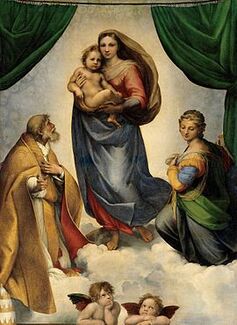Beauty in Dostoevsky
Beauty is a unifying theme explored in Dostoevsky’s novels. It is both enlightenment, the divine understanding of the harmony of the universe, and moral virtue, the highest degrees of compassion and altruism (Johnsons 15). Even though beauty exists in this abstract form, it is mostly explored and embodied through art, in an “image of beauty”, which, for Dostoevsky, is Christ, the incarnation of the Holy Spirit (Jackson 57). Man experiences two types of beauty: healthy beauty found in obraz (the ideal beauty discussed above, supreme aesthetic and religious beauty, the “Madonna”) and “another ideal,” unhealthy beauty found in bezobrazie (the disfiguration, violence, and sensualism found in man’s nature, “Sodom”) (Jackson 47, 58). Man finds pleasure in the destructive drives of his corporeal nature, yet strives for this spiritual ideal (Jackson 65). The craving for this beauty is also a craving for transfiguration (Johnsons 50). It takes time and suffering through considerable death and darkness in order to find it (Johnsons 34). This is the ideal and healthy beauty that Dostoevsky believed “will save the world” (The Idiot 415).
Epiphanies of Beauty
Many characters in Dostoevsky’s novels encounter epiphanies of beauty. These are moments of sudden divine insight and glimpses of supreme happiness and harmony that usually take place on the verge of real or perceived darkness (Johnsons 3, 6). Epiphanies of beauty have an important transformative element. They open the possibility for a character to change their path and appreciate life in a new way (Johnsons 9). Bridges are a great motif for beatific epiphanies because they symbolize both the sublime and beautiful and a transformational point. They illustrate the duality of paths and outcomes where the characters have free will to decide which side of the bridge they will cross (Johnsons 5). Beatific epiphanies are not only present in Dostoevsky’s stories but in his real life as well. Many times, Dostoevsky experienced a sudden realization that life is beautiful amidst moments of chaos and pain. For instance, when Dostoevsky was spared from a death sentence moments before his execution, he wrote in a letter to his brother that he was “being born again… in a new and better form” (qtd. in Johnsons 9). Moreover, it is known that Dostoevsky suffered from epilepsy. Before his fits took over his consciousness, he recalled experiencing epiphanies of beauty and harmony. He stated to his friend, Strakhov, that he “experience[d] a happiness that is impossible under ordinary circumstances, a complete harmony within [him]self and in the whole world” (qtd. in Johnsons 10). In a documented conversation with his friend S. V. Kovalevskaya, Dostoevsky also recounts that moments epileptic fit, he visited paradise and met God as the Islamic Prophet Mohammed (Johnsons 11).
Representations of Beauty in Dostoevsky’s novels
The Idiot - Prince Mishkin
Observing Prince Myshkin, we can find both epiphanies of beauty and the beauty of Christ. Myshkin is a character whose essence is beautiful. He is a Christ-like figure, Dostoevsky's biggest attempt to embody beauty in human form thrown in the chaos of 19-Century Russia (Johnsons 29). Myshkin is portrayed as innocent, pure, and chaste, but also mentally and physically ill. Preceding his epileptic fits, Myshkin experiences absolute beauty and harmony, “a higher tranquillity full of clear and harmonious joy and hope” (The Idiot 226). In those moments, filled with beauty and prayer, “an extraordinary inner light illuminates his soul”, and, as Dostoevsky notes, Myshkin becomes a “positively beautiful man” (The Idiot 234, 226). In his beatific epiphanies, Myshkin not only experiences beauty but becomes beauty itself. Because of his purity and innocence, he is able to experience beauty like no other character, making him resistant to the corruption of carnal pleasures (Jackson 53).
Works Cited
Brailovsky, Anna and Fyodor Dostoyevsky. The Idiot. The Modern Library, New York, USA, 2003.
Jackson, Robert L. "Two Kinds of Beauty." Close Encounters. Academic Studies Press, Boston, USA, 2019.
Johnson, Benjamin. The Briefest Moment: Epiphanies of Timeless Beauty in Dostoevsky's Novels, ProQuest Dissertations Publishing, 2010.


